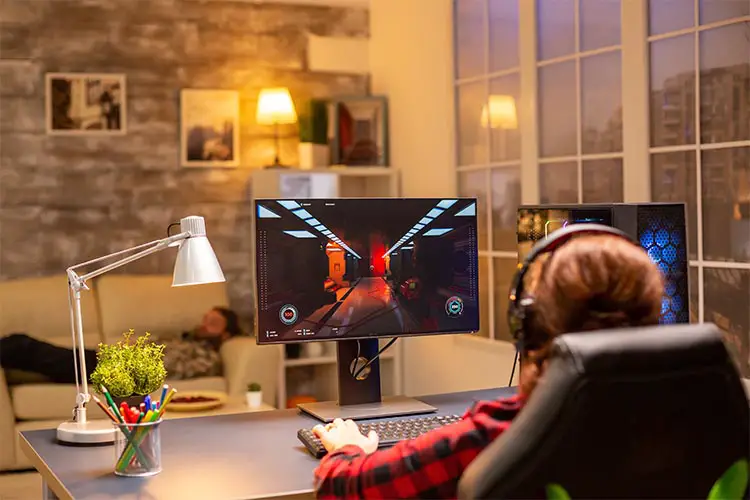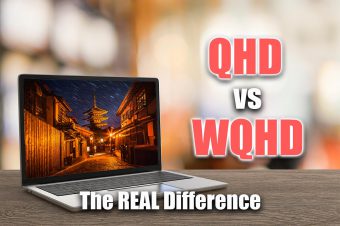When it comes to 1440p vs 4K (also known as Quad HD vs 4K) there is some debate about which one is better. Well, the simple answer is, what do you want to use the monitor for? Here’s a breakdown of how to approach this predicament.
What Is 1440p Resolution?
If you are not familiar with the nomenclature, 1440p refers to the resolution measured in pixels. It is short for 2560 x 1440. And the p stands for progressive (as opposed to 1440i which means interlaced). Screens with progressive resolution show an improved picture quality.
1440p is also referred to as quad high definition (QHD) because it is 4x times larger in total pixels than 720p, which is HD. Sometimes, it is also referred to as WQHD which means wide QHD, which has an aspect ratio of 16:9 instead of 4:3.
With laptops and computer monitors moving on from 1080p (full HD) it is important to note that 1440p has 78 percent more pixels compared to 1080p.

What Is 4K?
This is a term that you’ve probably heard a lot. That’s probably because it is a very popular choice for TV resolution and is often also referred to as Ultra HD. It offers 4x times the resolution when compared to 1080p. 4K resolution is 3840 x 2160 pixels and can also be called 2160p.
Not all computer monitors offer 4K resolution but manufacturers are catching up. It can be tricky to get a 4K monitor because it is very important to pair them with a top-notch CPU and GPU to gain maximum benefit.
Is 1440p 4K?
1440p is not 4K, as 1440p is 2560 x 1440 pixels, while 4K is 3840 x 2160 pixels. You can see the pros and cons of each resolution below.
4K: Pros

This resolution is often touted to be the future. So, it’s no surprise that it has a couple of interesting and impressive pros.
More Screen Real Estate
As mentioned before, the screen real estate of 4K resolution is four times that of 1080p resolution. Whether you are planning to watch TV or play games, 4K gives you a great experience because the extra pixels over lower resolutions allow for a much sharper image. This is the biggest asset of 4K.
The same is true for those who want to use their computer monitors for editing and designing purposes because you will be able to fit a lot on the screen which makes it easy to multitask. The user experience can be described as unmatched for the existing hardware.
Streaming Content
Now, if you are going to use your monitor exclusively to stream content, 4K is a terrific choice because a lot of content is being made available in 4K and the viewing experience is unparalleled.
4K: Cons
But as is the case with most things, 4K comes with a few cons too.
Can Be an Overkill Sometimes
This is a great choice but only if you know what you are going to use all that resolution for. It makes sense if you want to design graphics or watch 4K movies exclusively.
In fact, it’s a bit much even for gamers. But we’ll get to that in a minute. And it’s also pricey if you’re not going to use it for these specific purposes because it might need a hardware upgrade that you won’t put to use.
Scaling Problems
4K resolution is great but you must have a screen that is at least 32 inches in the diagonal, otherwise you might find that a lot of what is on your screen is too small to properly see. Text is totally unreadable if you don’t scale it by a lot.
This means even simple tasks like browsing the web will become a challenge. It also can cause issues with a lot of apps and programs, even if your screen is 40 inches.
1440p: Pros

1440p comes with a few delightful pros. Here’s a look at them.
Refresh Rate
When you have 1440p as the resolution and 144Hz as the refresh rate, you can do a lot from gaming to streaming content or just using the monitor for everyday use. It is a very popular combination with good reason and it’s not very expensive either.
Good for Small Monitors
This is a resolution that works well even for smaller monitors. In fact, the smaller the monitor, the better the definition of smaller images. And on bigger screens, you will get more workspace. So, size is not a problem here.
This is why these screens are great for tasks for photo and video editing.
1440p Cons
And as you would expect, there are a few specific setbacks with this one too.
Not for TV Content
If you are trying to watch content that is produced by television studios, you might not be all that satisfied because they are generally optimized for screens with a low resolution. The images might look better but they are meant for 1080p at best.
As a result, the apparent sharpness increases and this increase in detail makes the picture look unnatural. That means you’ll have to keep buying Blu-ray stuff to watch on your monitor or using the dedicated 4K streams of some streaming providers..
Cost
While there isn’t much difference between 1440p and 4K, both of them are quite expensive with respect to the other options. Add to that cost, you might also have to upgrade the graphics card for 1440p (although this might also be true of 4K), which makes this an expensive upgrade.
1440p vs 4K for Photo Editing
Photo editing is a pretty great experience with the supreme resolution of 4K. When you have a great picture in your hand, you will thoroughly enjoy zooming in and checking out the intricate details. And when you need screen space to work, well, you’ll have that too. It is not something you need, but you’ll definitely dig it.
There’s really no downsides to using 4K for photo editing, as refresh rate doesn’t matter at all. Don’t forget though, that you will likely need at least a 32-inch monitor to make 4K usable.
1440p vs 4K for Gaming

In this case, 4K isn’t the friend you think it is unless you are a console gamer. While both options are great for gaming, if you are competitive, you want a strong graphics card. And along with that, you want a higher refresh rate to match your high frame rate.
But 1440p will come at a decent price and lead you to a great gaming session. Most of these monitors come with a refresh rate of 144 Hz which is great for gaming. 4K monitors tend to offer lower refresh rates unless they are very expensive models, making them less suitable for gaming.
When to Buy a 1440p Monitor?
If you are a competitive gamer and don’t want to blow a hole in your wallet, then 1440p is the best choice for you. It is also a pretty good investment in terms of everyday productivity.
When to Buy a 4K Monitor?
If you want to stream 4K content or edit photos or create graphics, this is the way to go. It’s not for competitive games because while 4K is great in terms of image quality, the refresh rates are not.
1440p vs 4K: Final Thoughts

There are lots of reasons to want either of these resolutions in your monitor, and they’re all valid. But for my money, 4K is the way to go assuming that you are not gaming, and get at least a 32-inch monitor. If you want a smaller monitor, or gaming is important to you, then 1440p is your ideal resolution.
Read More:






Leave a Reply